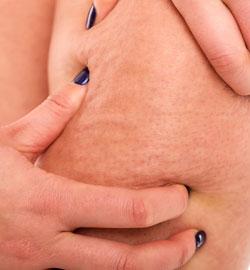


Cellulite is made up of normal fat cells trapped in lymphatic liquid and fibrous tissue.
This alteration of the fatty layer under the skin often affects young and older women and manifests itself with an excess of fat in the areas of the thigh, abdomen and hips. In many cases, the height to weight ratio is perfectly normal.
The well-defined, cellulite masses can be painful and can vary in size during the mentrual cycle.
The skin, puckered on the surface, looks like orange peel.
Cellulite can appear in people who are physically very active. Therefore, it is obvious that doctors who treat cellulitis should not consider the ‘calorie intake/calorie burning’ ratio as they would in cases of obesity.
The root of the problem may be found in the imbalance of hormone production: patients with cellulitis complain of irregular menstrual cycles and a period of post-ovulation with symptoms associated with hyperfolliculinia characterized by a weight gain of approximately 2 kg, discomfort, anzxiety, insomnia and pains in the breast and abdomen. These symptoms tend to increase gradually until the end of the menstrual cycle that has a liberating effect.
Cellulitis is often associated with circulatory problems: the legs are tired and aching and standing erect for prolonged periods is painful and, at the end of the day, feet and ankles are swollen.
If these problems are not addressed over the years, circulation becomes difficult causing the appearance of varicose veins.
